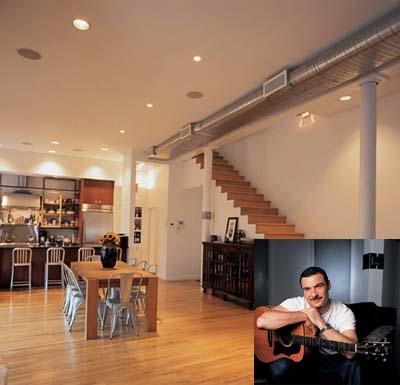Taking iCommand

Most of us would have our hands full just getting a whole-house audio/video system installed. Imagine taking on that task while starring in a Broadway play, directing your first feature film, and supervising the renovation of a 3,000-square-foot apartment. That was the confluence of challenges facing Liev Schreiber when the self-confessed "media geek" decided he wanted a state-of-the-art entertainment system.
One of New York's premier stage actors, having won a Tony this year for his performance as Ricky Roma in David Mamet's Glengarry Glen Ross, Schreiber, 37, is also a familiar face from the movies, having starred in all three Scream installments, The Sum of All Fears, A Walk on the Moon, and last year's remake of The Manchurian Candidate. And this fall, he made his film-directing debut with an acclaimed adaptation of Jonathan Safran Foer's novel Everything Is Illuminated, starring Elijah Wood. (See Josef Krebs's interview with Wood.)
You wouldn't think his demanding schedule would allow for it, but Schreiber was as hands-on in the planning of his NoHo apartment and its entertainment system as he was in the making of his movie. "As soon as we had the design of the space finalized, I talked to the installers about how we would handle the sound," he recalls. "And the prospect of what it would cost to install different systems in each room started to terrify me. But I'd seen setups in friends' houses that had a central location feeding all the rooms. When you do that, there's a hell of a lot of wiring, but there's only one stack of components."
Schreiber wanted a system that would be very simple to operate but also sophisticated and easy to upgrade. It not only had to handle the traditional chores of a home-entertainment system, but also had to accommodate the professional editing suite in his home office, where he was working on his movie. "Since people would be in different rooms watching or listening to different things, the rooms had to be able to run independently of each other," Schreiber says. "It seemed like i-Command was the smartest solution for that."
 B&W's new i-Command system uses computer-mouse-size modules called i-Nodes ($300 each), which can be attached to any component programmable via standard RS-232 serial codes. (For non-RS-232-compatible gear, there's a $600 infrared module called the ir-Node.) The i-Nodes are IP (Internet protocol) addressable and are hooked up to the entertainment network using standard Ethernet connections. Each i-Node identifies the component it's attached to, determines what the component's control codes are, and then sends that information to the other gear in the system. This allows for two-way communication between everything on the network as well as with the i-Command Tablet touchscreen controller ($3,500, shown with the i-Node, right). It also allows the system to essentially configure itself.
B&W's new i-Command system uses computer-mouse-size modules called i-Nodes ($300 each), which can be attached to any component programmable via standard RS-232 serial codes. (For non-RS-232-compatible gear, there's a $600 infrared module called the ir-Node.) The i-Nodes are IP (Internet protocol) addressable and are hooked up to the entertainment network using standard Ethernet connections. Each i-Node identifies the component it's attached to, determines what the component's control codes are, and then sends that information to the other gear in the system. This allows for two-way communication between everything on the network as well as with the i-Command Tablet touchscreen controller ($3,500, shown with the i-Node, right). It also allows the system to essentially configure itself.
Since the i-Nodes are IP addressable, the system can be called up via the Web from anywhere in the world. This lets the technicians at i-Command or a custom installer check out a problem without having to make a house call or rely on the homeowner to describe what's gone wrong. It also allows a tech-savvy user like Schreiber to check in on the system when he's traveling.
- Log in or register to post comments


























































